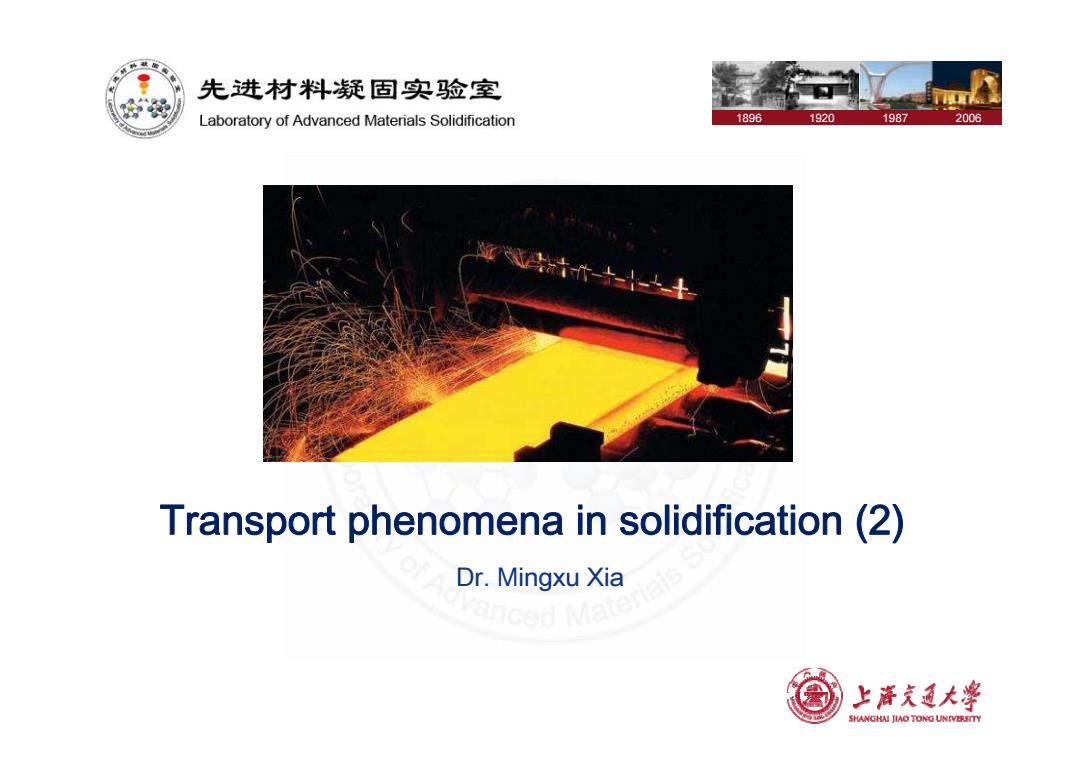
先进材料疑固实验室 Laboratory of Advanced Materials Solidification 1896 1920 1987 2006 道清什--土 Transport phenomena in solidification(2) Dr.Mingxu Xia 上降充通大学 SHANGHAI JIAO TONG UNIVERSTTY
1896 19 02 1987 2006 Transport phenomena in solidification (2) Dr. Mingxu Xia

先进材料疑固实验室 Outline Laboratory of Advanced Materials Solidification Brief introduction Momentum transport ⑧Heat transfer Mass transfer Commonalities among phenomena 上谱克通大睾 SHANGHAI JIAO TONG UNIVERSTTY
Outline Brief introduction Momentum transport Heat transfer Mass transfer Commonalities among phenomena
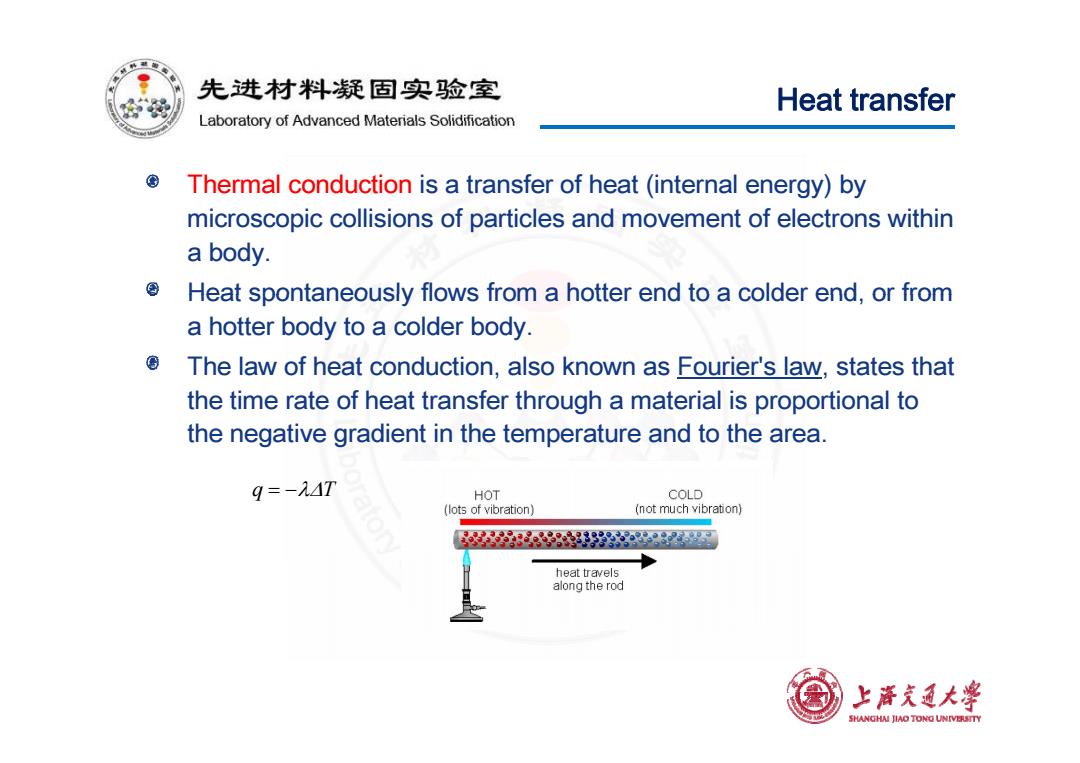
先进材料疑固实验室 Heat transfer Laboratory of Advanced Materials Solidification Thermal conduction is a transfer of heat (internal energy)by microscopic collisions of particles and movement of electrons within a body. Heat spontaneously flows from a hotter end to a colder end,or from a hotter body to a colder body. The law of heat conduction,also known as Fourier's law,states that the time rate of heat transfer through a material is proportional to the negative gradient in the temperature and to the area. q=-MAT HOT COLD (lots of vibration) (not much vibration) 号88892828 heat travels along the rod 上降充通大学 SHANGHAI JIAO TONG UNIVERSTTY
Heat transfer Thermal conduction is a transfer of heat (internal energy) by microscopic collisions of particles and movement of electrons within a body. Heat spontaneously flows from a hotter end to a colder end or from Heat spontaneously flows from a hotter end to a colder end, or from a hotter body to a colder body. The law of heat conduction, also known as Fourier's law, states that the time rate of heat transfer through a material is proportional to the negative gradient in the temperature and to the area. q T
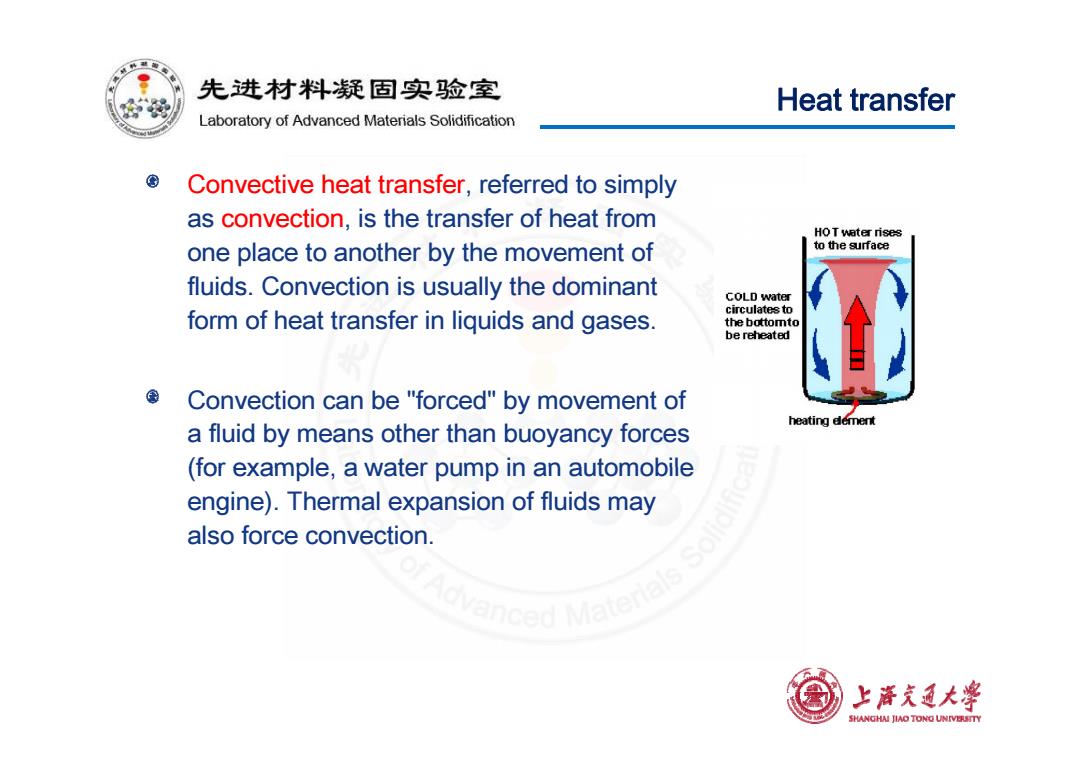
先进材料疑固实验室 Heat transfer Laboratory of Advanced Materials Solidification Convective heat transfer,referred to simply as convection,is the transfer of heat from HO T weter rises one place to another by the movement of to the surface fluids.Convection is usually the dominant COLD water form of heat transfer in liquids and gases. circulates to the bottomto be reheated Convection can be "forced"by movement of heating element a fluid by means other than buoyancy forces (for example,a water pump in an automobile engine).Thermal expansion of fluids may also force convection. HGEMatsnle 上降充通大学 SHANGHAI JIAO TONG UNIVERSTTY
Heat transfer Convective heat transfer, referred to simply as convection, is the transfer of heat from one place to another by the movement of fluids. Convection nvection is usually the dominant form of heat transfer in liquids and gases. Convection can be "forced" by movement of a fluid by means other than buoyancy forces (for example a water pump in an automobile (for example, a water pump in an automobile engine). Thermal expansion of fluids may also force convection
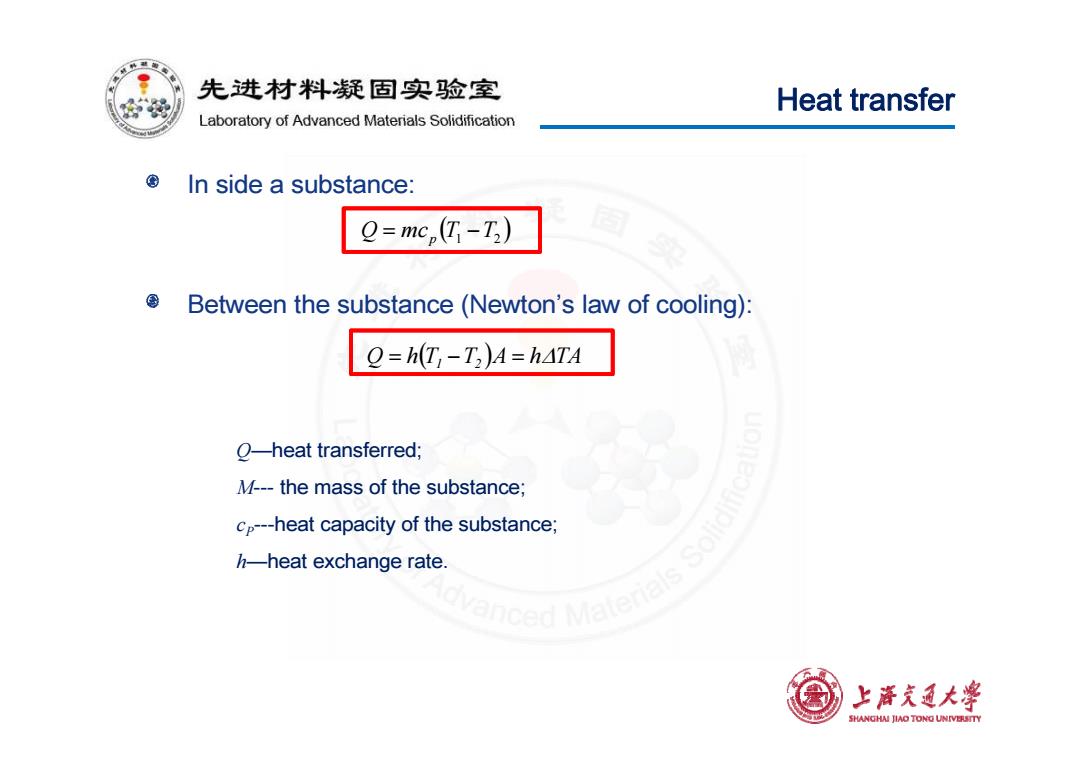
先进材料疑固实验室 Heat transfer Laboratory of Advanced Materials Solidification In side a substance: e=mc,(T-T2) Between the substance(Newton's law of cooling): Q=h(T;-T:)4=h4TA O-heat transferred; M---the mass of the substance; vanced Materials Solid cp---heat capacity of the substance; h-heat exchange rate. 上降文通大学 SHANGHAI JIAO TONG UNIVERSTTY
Heat transfer In side a substance: ( f) Q mcp T1 T2 Between the substance (Newton’s law of cooling): Q hT1 T2 A hTA Q—heat transferred; M--- the mass of the substance; cP---heat capacity of the substance; h—ht h t eat exchange rate
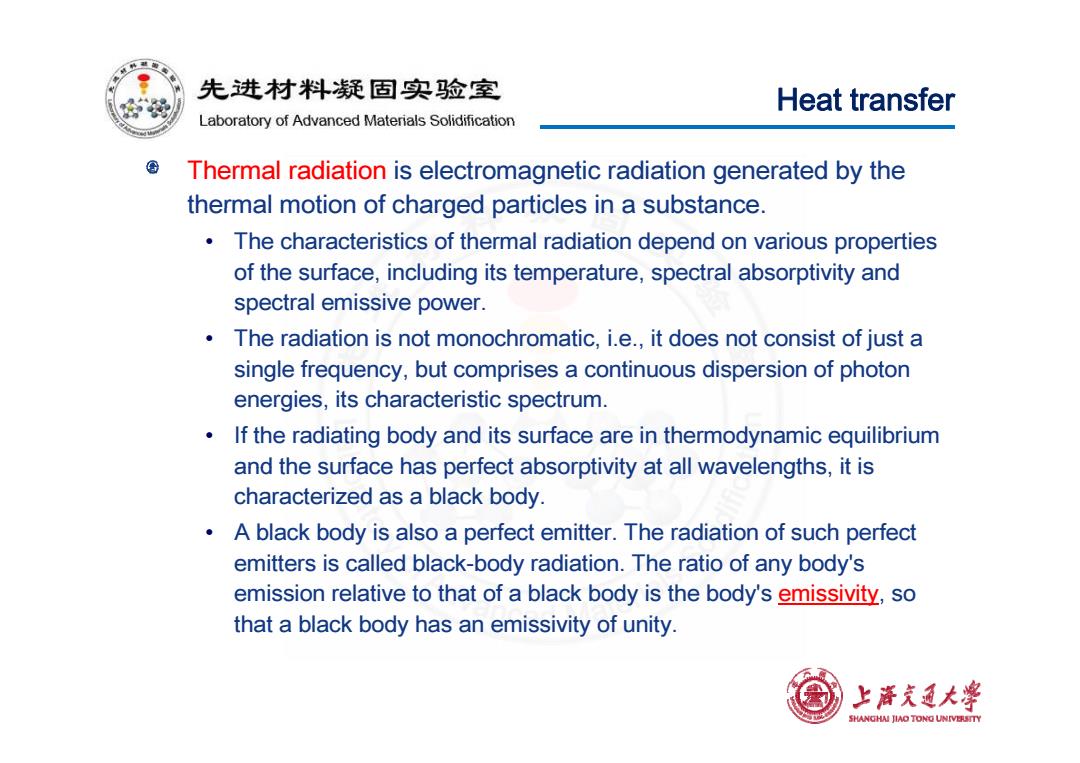
先进材料疑固实验室 Heat transfer Laboratory of Advanced Materials Solidification Thermal radiation is electromagnetic radiation generated by the thermal motion of charged particles in a substance. The characteristics of thermal radiation depend on various properties of the surface,including its temperature,spectral absorptivity and spectral emissive power. The radiation is not monochromatic,i.e.,it does not consist of just a single frequency,but comprises a continuous dispersion of photon energies,its characteristic spectrum. If the radiating body and its surface are in thermodynamic equilibrium and the surface has perfect absorptivity at all wavelengths,it is characterized as a black body. A black body is also a perfect emitter.The radiation of such perfect emitters is called black-body radiation.The ratio of any body's emission relative to that of a black body is the body's emissivity,so that a black body has an emissivity of unity. 上降充通大学 SHANGHAI JIAO TONG UNIVERSTTY
Heat transfer Thermal radiation is electromagnetic radiation generated by the thermal motion of charged particles in a substance thermal motion of charged particles in a substance. • The characteristics of thermal radiation depend on various properties of the surface, including its temperature, spectral absorptivity and spectl ii ra emissive power. • The radiation is not monochromatic, i.e., it does not consist of just a singqy p p p le frequency, but comprises a continuous dispersion of photon energies, its characteristic spectrum. • If the radiating body and its surface are in thermodynamic equilibrium and the surface has perfect and the surface has perfect absorptivity absorptivity at all wavelengths it is at all wavelengths, it is characterized as a black body. • A black body is also a perfect emitter. The radiation of such perfect emi i ll d bl k itters is called black-b d di i Th i f b d ' body radiation. The ratio of any body's emission relative to that of a black body is the body's emissivity, so that a black body has an emissivity of unity

先进材料疑固实验室 Heat transfer Laboratory of Advanced Materials Solidification The emitted heat energy is E=80,T4 Where a is the emissive rate; is the constant 5.67x 10-8 W/(m2K4) T is the surface temperature of objective aopyotAdancedleerassoaicatio 上降文通大学 SHANGHAI JIAO TONG UNIVERSTTY
Heat transfer The emitted heat energy is Where ε is the emissive rate; 8 2 4 σ 0 is the constant = 5.67x 10-8 W/(m 2 K 4) T is the surface temperature of objective
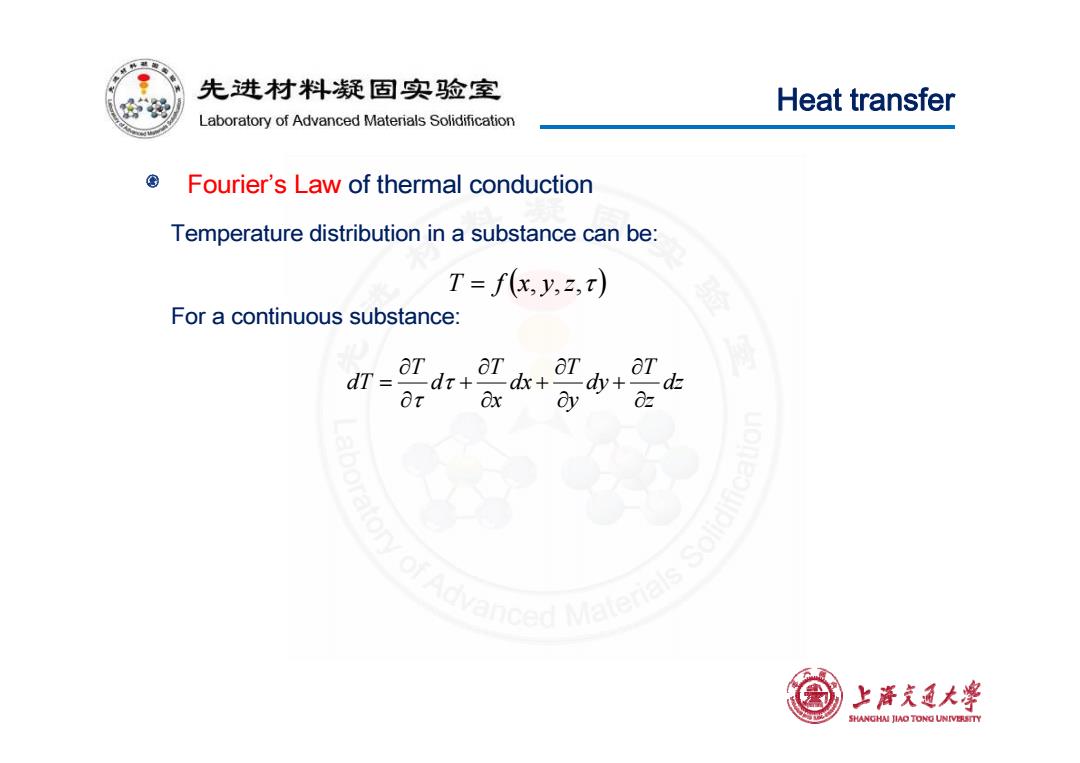
先进材料疑固实验室 Heat transfer Laboratory of Advanced Materials Solidification Fourier's Law of thermal conduction Temperature distribution in a substance can be: T=f(x,y,z,r) For a continuous substance: dT= 正也 Or ay 02 aonoAdaicehaeiasSdicaio 上降文通大学 SHANGHAI JIAO TONG UNIVERSTTY
Heat transfer Fourier’s Law of thermal conduction Temperature distribution in a substance can be: T f x, y,z, For a continuous substance: f , y, , dz T dy T dx T d T dT dz z dy y dx x dT d
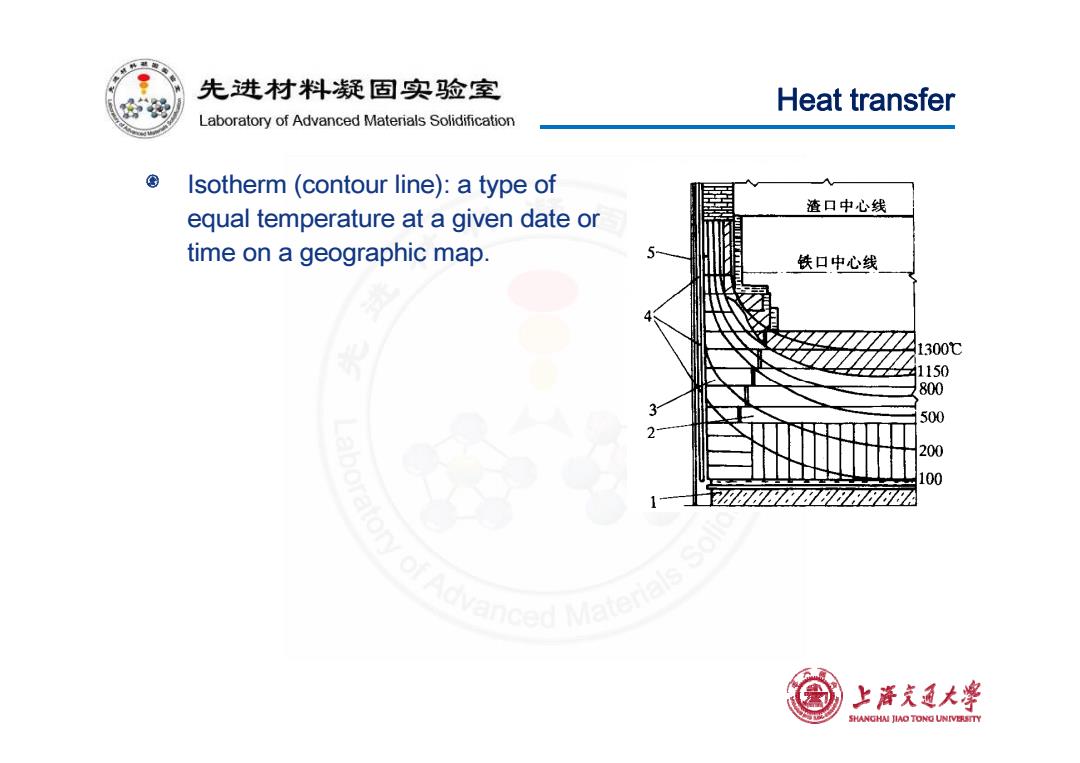
先进材料疑固实验室 Heat transfer Laboratory of Advanced Materials Solidification Isotherm(contour line):a type of 渣口中心线 equal temperature at a given date or time on a geographic map. 铁口中心线 300℃ 150 800 500 200 100 Oratory of Advanced Materialss 上降文通大学 SHANGHAI JIAO TONG UNIVERSITY
Heat transfer Isotherm (contour line): a type of equal temperature at a given date or time on a geographic map

先进材料疑固实验室 Heat transfer Laboratory of Advanced Materials Solidification Temperature gradient: The minimum ratio of the temperature difference between two isothermal surface to the distance in t+△t gradt the normal direction. △n AT OT gradT lim △nan gradT- t-△t q-号=-gar- OT 9x=-1 9,=-1 aT q=iqs +jqy +kq: 9.=-1 02 上降文通大学 SHANGHAI JIAO TONG UNIVERSTTY
Heat transfer Temperature gradient: The minimum ratio of the temperature difference between two isothermal surface to the distance in the normal direction. n T n T gradT lim z T k y T j x T gradT i x T qx T n T gradT FQ q x y qz q i q jq k y T qy z T qz z